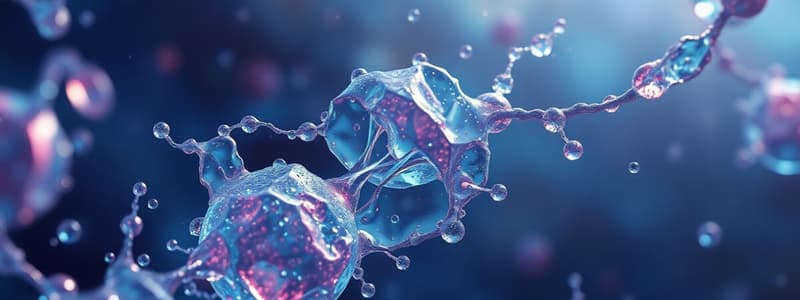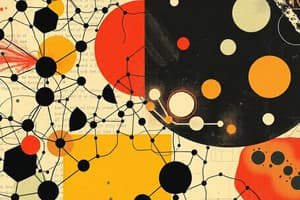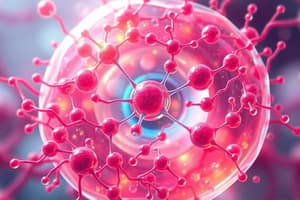Podcast
Questions and Answers
What percentage of different animal parts commonly contain water?
What percentage of different animal parts commonly contain water?
- 50-70%
- 0-50%
- 5-95% (correct)
- 65-75% (correct)
Carbon dioxide is primarily used for respiration in air-breathing animals.
Carbon dioxide is primarily used for respiration in air-breathing animals.
False (B)
Name one type of organic compound.
Name one type of organic compound.
Carbohydrates, Proteins, or Lipids
The simplest type of carbohydrate is called a __________.
The simplest type of carbohydrate is called a __________.
Match the following types of carbohydrates with their characteristics:
Match the following types of carbohydrates with their characteristics:
Which of the following is NOT a type of monosaccharide?
Which of the following is NOT a type of monosaccharide?
Lipids are the most abundant type of organic compound in nature.
Lipids are the most abundant type of organic compound in nature.
Water has a high __________, which helps it absorb large amounts of heat without changing temperature.
Water has a high __________, which helps it absorb large amounts of heat without changing temperature.
Who is credited with observing the first cells in cork?
Who is credited with observing the first cells in cork?
Rudolf Virchow proposed that plants arise only from other plants.
Rudolf Virchow proposed that plants arise only from other plants.
What did Robert Brown describe as the central feature in plant cells?
What did Robert Brown describe as the central feature in plant cells?
The first handheld microscope was invented by __________.
The first handheld microscope was invented by __________.
Match the scientist with their contribution to cell biology:
Match the scientist with their contribution to cell biology:
What is the basic unit of life according to the modern cell theory?
What is the basic unit of life according to the modern cell theory?
Most cells are visible to the unaided eye.
Most cells are visible to the unaided eye.
Who conducted a collaborative study on the similarity of structure and growth in animals and plants?
Who conducted a collaborative study on the similarity of structure and growth in animals and plants?
What phase of the cell cycle is primarily characterized by DNA replication?
What phase of the cell cycle is primarily characterized by DNA replication?
During mitosis, the chromatin condenses into visible chromosomes.
During mitosis, the chromatin condenses into visible chromosomes.
Which organelle is responsible for synthesizing and secreting steroid hormones?
Which organelle is responsible for synthesizing and secreting steroid hormones?
What occurs during the G1 phase of interphase?
What occurs during the G1 phase of interphase?
In mitosis, double chromosomes begin to separate towards the opposite ______.
In mitosis, double chromosomes begin to separate towards the opposite ______.
Microfilaments are primarily responsible for cell division.
Microfilaments are primarily responsible for cell division.
Match the phases of mitosis with their key characteristics:
Match the phases of mitosis with their key characteristics:
What are glyoxysomes mainly found in, and what is their function?
What are glyoxysomes mainly found in, and what is their function?
Which of the following is NOT a phase of interphase?
Which of the following is NOT a phase of interphase?
The _____ is an organelle that contains chlorophyll and is involved in photosynthesis.
The _____ is an organelle that contains chlorophyll and is involved in photosynthesis.
Match the following organelles with their primary functions:
Match the following organelles with their primary functions:
The spindle formation is complete during prophase.
The spindle formation is complete during prophase.
Which of the following plastids contain red and yellow pigments?
Which of the following plastids contain red and yellow pigments?
What is the main function of integral proteins in the cell membrane?
What is the main function of integral proteins in the cell membrane?
What is the primary purpose of mitosis?
What is the primary purpose of mitosis?
The nucleus is the smallest organelle in a eukaryotic cell.
The nucleus is the smallest organelle in a eukaryotic cell.
Lysosomes are known to be a waste disposal system in animal cells.
Lysosomes are known to be a waste disposal system in animal cells.
What structure serves as the powerhouse of the cell?
What structure serves as the powerhouse of the cell?
What is the primary component that forms microtubules?
What is the primary component that forms microtubules?
Cells use __________ to engulf particles by folding their membrane to form a vacuole.
Cells use __________ to engulf particles by folding their membrane to form a vacuole.
What are the two types of proteins present in the cell membrane?
What are the two types of proteins present in the cell membrane?
The smooth endoplasmic reticulum is responsible for ribosome production.
The smooth endoplasmic reticulum is responsible for ribosome production.
What are the components of chromatin in the nucleus?
What are the components of chromatin in the nucleus?
Which of the following is not a type of chromosomal mutation?
Which of the following is not a type of chromosomal mutation?
Translocation involves the movement of a chromosome segment from one homologous chromosome to another.
Translocation involves the movement of a chromosome segment from one homologous chromosome to another.
What syndrome is caused by a deletion on chromosome 7?
What syndrome is caused by a deletion on chromosome 7?
Inversions can cause _____ defects and/or abnormal development.
Inversions can cause _____ defects and/or abnormal development.
Match each type of chromosomal mutation with its definition:
Match each type of chromosomal mutation with its definition:
Which agent is NOT known to cause chromosomal mutations?
Which agent is NOT known to cause chromosomal mutations?
Duplication of chromosome segments can always cause visible abnormalities.
Duplication of chromosome segments can always cause visible abnormalities.
What is one practical application of DNA technology in the medical field?
What is one practical application of DNA technology in the medical field?
Flashcards
Water in Organisms
Water in Organisms
Water makes up a significant portion of living organisms, ranging from 5% to 95% in various animal parts with an average of 65-75%.
Water: Universal Solvent
Water: Universal Solvent
Water is known as the universal solvent due to its ability to dissolve a wide variety of substances.
Inorganic Salts
Inorganic Salts
Inorganic salts are essential minerals found in living organisms, often playing structural roles in bones, shells, and teeth.
Carbohydrates: Role and Importance
Carbohydrates: Role and Importance
Signup and view all the flashcards
Monosaccharides: Simple Sugars
Monosaccharides: Simple Sugars
Signup and view all the flashcards
Disaccharides: Double Sugars
Disaccharides: Double Sugars
Signup and view all the flashcards
Glucose: Energy Source
Glucose: Energy Source
Signup and view all the flashcards
Ribose: Nucleic Acid Component
Ribose: Nucleic Acid Component
Signup and view all the flashcards
What is a cell?
What is a cell?
Signup and view all the flashcards
Why was the microscope important in cell biology?
Why was the microscope important in cell biology?
Signup and view all the flashcards
Who invented the compound microscope?
Who invented the compound microscope?
Signup and view all the flashcards
What did Robert Hooke observe in 1665?
What did Robert Hooke observe in 1665?
Signup and view all the flashcards
Who was the first to describe microscopic organisms?
Who was the first to describe microscopic organisms?
Signup and view all the flashcards
What did Mirbel and Lamarck propose about cells?
What did Mirbel and Lamarck propose about cells?
Signup and view all the flashcards
Who discovered the nucleus in plant cells?
Who discovered the nucleus in plant cells?
Signup and view all the flashcards
Who contributed to the cell theory by studying plants and animals?
Who contributed to the cell theory by studying plants and animals?
Signup and view all the flashcards
Smooth ER
Smooth ER
Signup and view all the flashcards
Golgi complex
Golgi complex
Signup and view all the flashcards
Microbodies
Microbodies
Signup and view all the flashcards
Glyoxysomes
Glyoxysomes
Signup and view all the flashcards
Fluid Mosaic Model
Fluid Mosaic Model
Signup and view all the flashcards
Peripheral Membrane Proteins
Peripheral Membrane Proteins
Signup and view all the flashcards
Integral Membrane Proteins
Integral Membrane Proteins
Signup and view all the flashcards
Active Transport
Active Transport
Signup and view all the flashcards
Pinocytosis
Pinocytosis
Signup and view all the flashcards
Mitochondria
Mitochondria
Signup and view all the flashcards
Nucleus
Nucleus
Signup and view all the flashcards
Rough ER
Rough ER
Signup and view all the flashcards
Interphase
Interphase
Signup and view all the flashcards
Mitosis
Mitosis
Signup and view all the flashcards
Prophase
Prophase
Signup and view all the flashcards
Metaphase
Metaphase
Signup and view all the flashcards
Anaphase
Anaphase
Signup and view all the flashcards
Telophase
Telophase
Signup and view all the flashcards
Chromosome
Chromosome
Signup and view all the flashcards
Centromere (Kinetochore)
Centromere (Kinetochore)
Signup and view all the flashcards
Chromosomal Mutation
Chromosomal Mutation
Signup and view all the flashcards
Deletion Syndrome
Deletion Syndrome
Signup and view all the flashcards
Williams Syndrome
Williams Syndrome
Signup and view all the flashcards
Duplication
Duplication
Signup and view all the flashcards
Inversion
Inversion
Signup and view all the flashcards
Translocation
Translocation
Signup and view all the flashcards
Alagille Syndrome
Alagille Syndrome
Signup and view all the flashcards
Practical Applications of DNA Technology
Practical Applications of DNA Technology
Signup and view all the flashcards
Study Notes
Biology Overview
- Biology is the scientific study of life, derived from the Greek words "bios" (life) and "logos" (study).
- Life is a complex chemical phenomenon exhibited by living organisms.
- Key characteristics of living organisms include metabolism (catabolic and anabolic reactions), growth, irritability (responding to stimuli), reproduction, form and size (complex organization), and chemical composition (elements like carbon, hydrogen, oxygen, nitrogen).
- A virus is considered an intermediate between living and nonliving things.
Branches of Biology
- Botany: The scientific study of plants, encompassing structure, physiology, reproduction, evolution, diseases, economic uses, and other plant characteristics.
- Zoology: The scientific study of animals.
- Microbiology: The study of microorganisms.
Subdivisions of Biology
- Biosystematics: The modern term for taxonomy, dealing with the identification, naming, and classification of organisms.
- Entomology: The study of insects.
- Ornithology: The study of birds.
- Herpetology: The study of reptiles and amphibians.
- Cnidarology: The study of corals.
- Ichthyology: The study of fishes.
- Bryology: The study of mosses and liverworts.
- Pteridology: The study of ferns.
- Mycology: The study of fungi.
- Phycology: The study of algae.
- Bacteriology: The study of bacteria.
- Biogeography: The study of the geographic distribution of organisms, with sub-divisions of phytogeography (plant geography) and zoogeography (animal geography).
- Molecular biology/biochemistry: The study of the chemistry of living things, encompassing gene biology and organic chemistry.
- Cell biology/cytology: The study of cells.
- Histology: The study of tissues.
- Organismic biology: The study of organ systems.
- Ecology: The study of the relationship of organisms and their environment, encompassing some community biology principles.
- Morphoanatomy: The study of the structure (gross) of living organisms.
- Physiology: The study of biological functions.
- Genetics: The study of heredity and variation.
- Reproductive biology: The study of reproduction.
- Developmental biology: The study of the development of organisms from gamete formation to birth, including embryology and other developmental processes.
- Paleontology: The study of fossil records.
- Pathology: The study of disease.
- Parasitology: The study of parasites.
- Ethology: The study of animal behavior.
Scientific Method
- Scientific investigations use logical steps: consult prior knowledge, make observations, formulate hypotheses, design a controlled experiment, collect data, interpret data, and draw conclusions.
Theories on the Origin of Life
- Theory of divine creation: Life was created by a divine entity.
- Interplanetary Theory: Life arrived on Earth from space.
- Spontaneous generation (abiogenesis): Life arose from non-living matter.
- Biogenesis: Life only comes from pre-existing life.
Cell as the Unit of Life
- The cell is the basic structural and functional unit of living organisms.
- The development of the microscope was critical to identifying and understanding cells.
- Key figures in cell biology include Zacharias Jansen (inventor of the compound microscope), Robert Hooke (who first described cells), and Anton van Leeuwenhoek (who first observed living cells).
- Modern cell theory states that cells are the basic units of life, all organisms are made of cells, and all cells arise from pre-existing cells.
Prokaryotic and Eukaryotic Cells
- Prokaryotic cells: Lack a nucleus and membrane-bound organelles, with DNA located in a nucleoid region. Examples include bacteria.
- Eukaryotic cells: Possess a nucleus and membrane-bound organelles, found in plants and animals.
- Organelles are discrete, membrane-bound structures within eukaryotic cells where metabolic processes take place. Examples include mitochondria (energy production), the nucleus (DNA control), endoplasmic reticulum (protein synthesis pathways), Golgi apparatus (modifies and packages proteins), microbodies (peroxisomes, glyoxysomes, lysosomes), microtubules provide structural support, centrioles involved in cell division, microfilaments involved in cell movement and shape, and plasmids (circular DNA in some prokaryotic cells)
Cell Membrane
- The cell membrane (plasma membrane) regulates substance passage into and out of the cell.
- Composed of a phospholipid bilayer with embedded proteins.
- The fluid mosaic model describes the cell membrane as a dynamic structure where proteins move within the lipid bilayer.
Transport Mechanisms
- Passive transport (diffusion, facilitated diffusion): Movement of substances across the membrane without energy.
- Active transport: Movement of substances against the concentration gradient, requiring energy (often ATP).
Cell Division (Mitosis)
- Mitosis is the process of cell division producing two genetically identical diploid daughter cells.
- Interphase is the period of cell growth and preparation prior to mitosis, including the phases G1, S, G2, and Go.
- Mitosis has phases: prophase, metaphase, anaphase, and telophase.
Cell Division (Meiosis)
- Meiosis is the cell division process in germ cells producing haploid daughter cells with half the original chromosomes count.
Pattern of Inheritance
- Mendel's laws describe patterns of inheritance that include the law of segregation, the law of independent assortment.
- Non-Mendelian inheritance patterns exist including incomplete dominance (intermediate phenotypes) and codominance (mixture of both homozygous traits).
- Lethal genes can result in the death of an organism.
- Chromosomal mutations can occur in the structure or placement of genetic information. Examples include deletion, duplication, inversion, and translocation.
DNA Technology
- Genetic engineering involves manipulating genetic material for specific purposes, like producing new substances or functions.
- Techniques like Recombinant DNA technology involve inserting genes from one organism into another.
- Selective breeding and hybridization techniques (modifying organisms by selection of traits) existed before genetic engineering.
- Genetic modification in plants introduces desired traits, such as herbicide resistance or enhanced nutritional value (like golden rice).
- Genetic modification in animals aims to develop traits like disease resistance or enhanced growth.
Other Important Biological Concepts Relevant to Study Notes
- Includes a summary of the content on pages 1-87 of the slides.
Studying That Suits You
Use AI to generate personalized quizzes and flashcards to suit your learning preferences.




